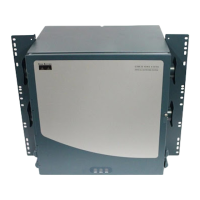14-5
Cisco ONS 15454 Procedure Guide, R5.0
December 2004
Chapter 14 Add and Remove Nodes
NTP-A212 Add a BLSR Node
Note If you map the K3 byte to another byte (such as E2), you must remap the line cards on either side
of the new node to the same byte. See the “DLP-A89 Remap the K3 Byte” task on page 17-87.
Step 17 Complete the “DLP-A60 Log into CTC” task on page 17-66 at a BLSR node that will connect to the new
node.
Step 18 Referring to the diagram created in Step 1, complete the “DLP-A303 Initiate a BLSR Force Ring
Switch” task on page 20-3 on the node that will connect to the new node on its west line (port). In the
Figure 14-2 on page 14-3 example, the BLSR force ring would occur at Node 1, West line (Slot 5 and 6).
Step 19 Referring to the diagram created in Step 1, complete the “DLP-A303 Initiate a BLSR Force Ring
Switch” task on page 20-3 on the node that will connect to the new node on its east line (port). In the
Figure 14-2 on page 14-3 example, the BLSR force ring would occur at Node 3, East line (Slot 12 and
13).
Step 20 Click the Alarms tab.
a. Verify that the alarm filter is not on. See the “DLP-A227 Disable Alarm Filtering” task on
page 19-17 as necessary.
b. Verify that no unexplained alarms appear on the network. If alarms appear, investigate and resolve
them before continuing. Refer to the Cisco ONS 15454 Troubleshooting Guide for procedures.
Step 21 Following the diagram created in Step 1, remove the fiber connections from the two nodes that will
connect to the new node.
a. Remove the west fiber from the node that will connect to the east port of the new node. In the
Figure 14-1 on page 14-2 example, this is Node 1, Slot 5, and in Figure 14-2 on page 14-3 this is
Node 1, Slots 5 and 6.
b. Remove the east fiber from the node that will connect to the west port of the new node. In the
Figure 14-1 on page 14-2 example, this is Node 3, Slot 12, and in Figure 14-2 on page 14-3 this is
Node 3, Slots 12 and 13.
Step 22 Connect fibers from the adjacent nodes to the new node following the diagram created in Step 1. Connect
the west port to the east port and the east port to the west port. For four-fiber BLSRs, connect the protect
fibers.
Step 23 After the newly added node appears in network view, double-click it to display the node in node view.
Step 24 Click the Provisioning > BLSR tabs.
Step 25 Click Ring Map. Verify that the new node appears on the Ring Map with the other BLSR nodes, then
click OK.
Step 26 From the View menu, choose Go to Network View and check the following:
a. Click the Provisioning > BLSR tabs. Verify that the new node appears under the Node column.
b. Click the Alarms tab. Verify that BLSR alarms such as RING MISMATCH, E-W MISMATCH,
PRC-DUPID (duplicate node ID), and APSCDFLTK (default K) do not appear.
If the new node does not appear in the Node column, or if BLSR alarms are present, log into the new
node and verify that the BLSR is provisioned on it correctly with the information from Steps 10 and 11.
If the node still does not appear, or if alarms persist, refer to the Cisco ONS 15454 Troubleshooting
Guide.
Step 27 Click the Circuits tab. Wait until all the circuits are discovered. The circuits that pass through the new
node will be shown as incomplete.

